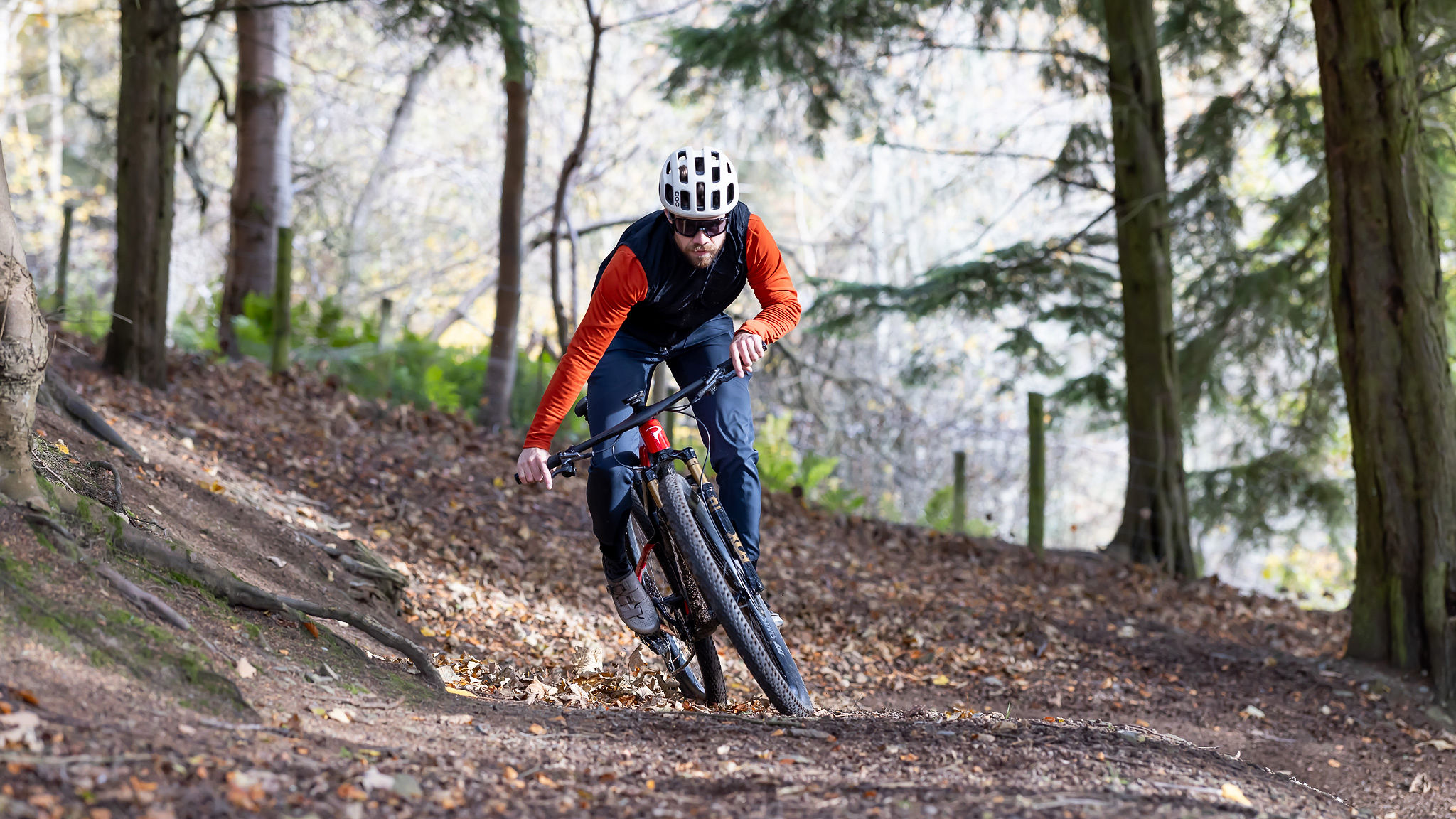Best mountain bike sunglasses – we test the top MTB eyewear for protection and clear vision
Our experts choose 10 of the best mountain bike sunglasses that will protect your eyes from debris, harmful UV rays, and keep you looking stylish on the trail
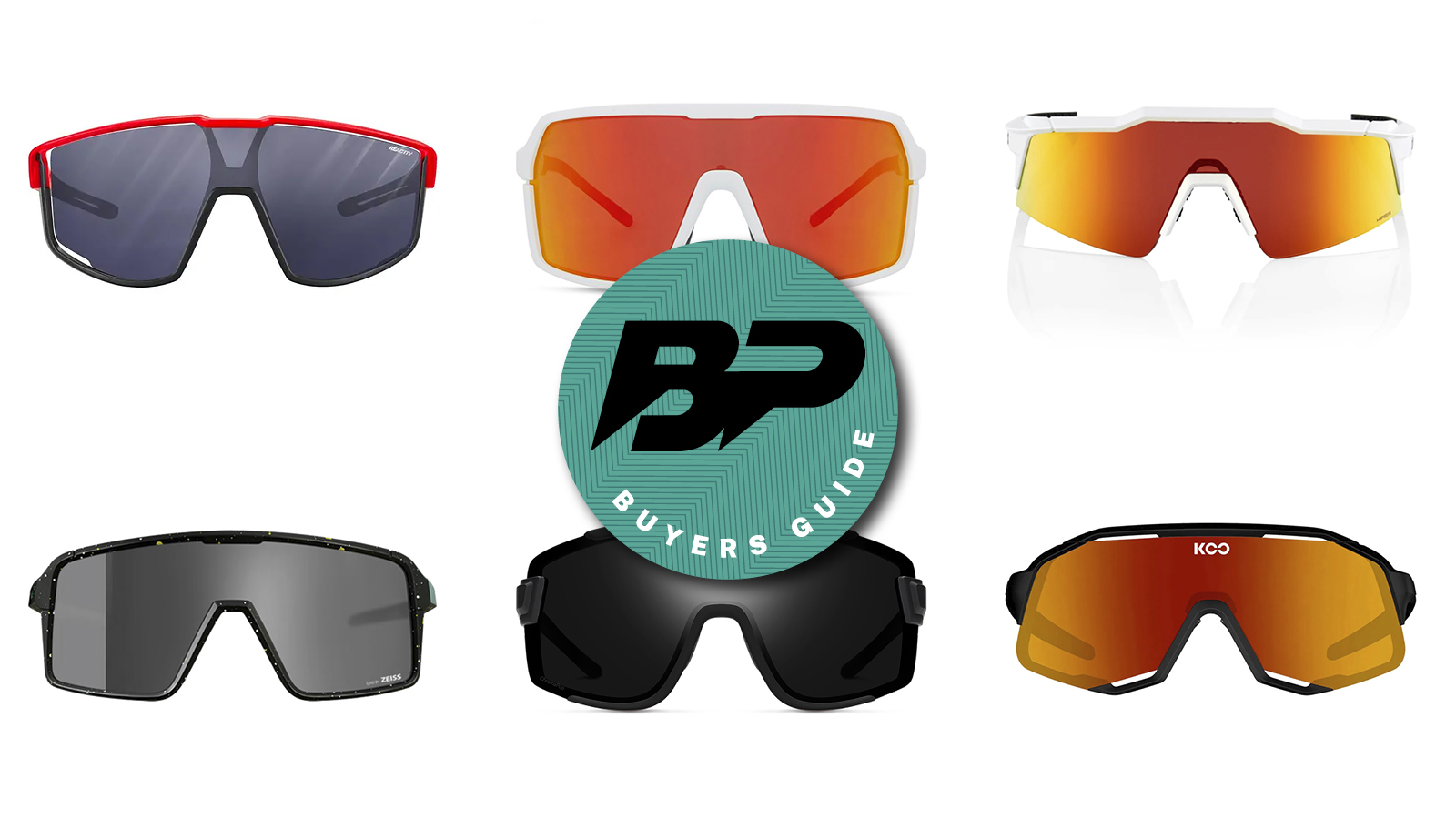
The best mountain bike sunglasses can transform your ride from a sketchy eye-watering blur to a thrilling high-definition experience. Not only do the best glasses keep your vision clear and defend against harmful UV rays, but they're also a vital protection against mud, dust and general trail debris.
For riding glasses to perform as best as possible, they need to fit perfectly too so getting the right ones for you and your proportions is a must. You'll probably want your pair of MTB glasses to look stylish too, and look good alongside the best mountain bike helmets and MTB jerseys.
With all of these considerations in mind, our experts have been putting the best mountain bike sunglasses to the test to compile this in-depth buying guide. We've covered every option here, from top-of-the-range to budget models, and picked out the best photochromic MTB glasses too.
Read on for our complete review list, or skip to the bottom of the article if you need advice on what to look for when choosing the best mountain bike sunglasses.
If you're a gravity rider who would perhaps benefit from wearing goggles over glasses, then make sure to check out our guide to the best MTB goggles too.
The best mountain bike sunglasses
Why trust BikePerfect
The quick list
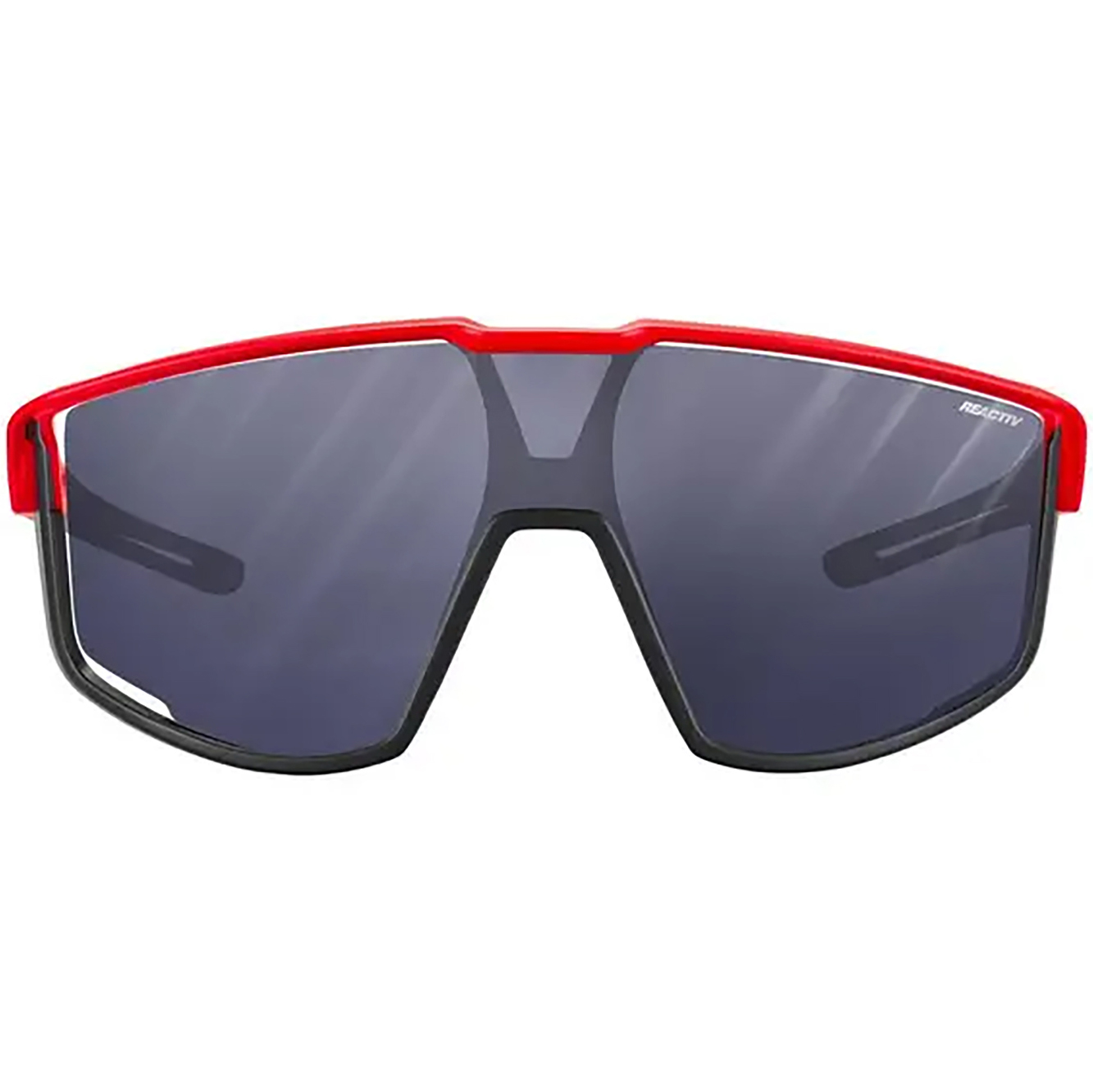
Best mountain bike sunglasses overall
Zero distortion, steam-free clarity, a secure comfortable fit, full coverage protection, and outstandingly tough.
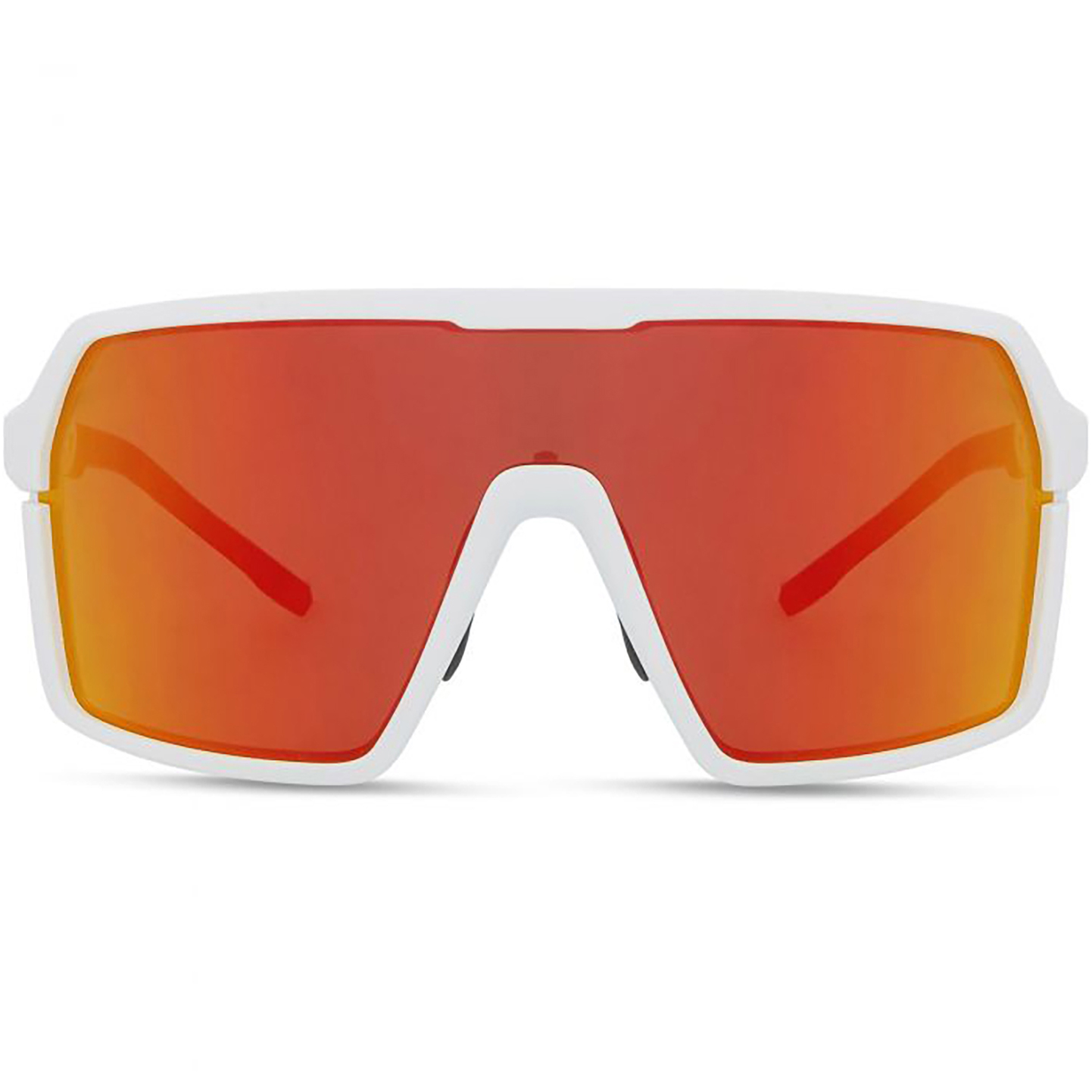
Best value mountain bike sunglasses
A large, stylish big-coverage design, with three lenses for different conditions, and at a killer price.
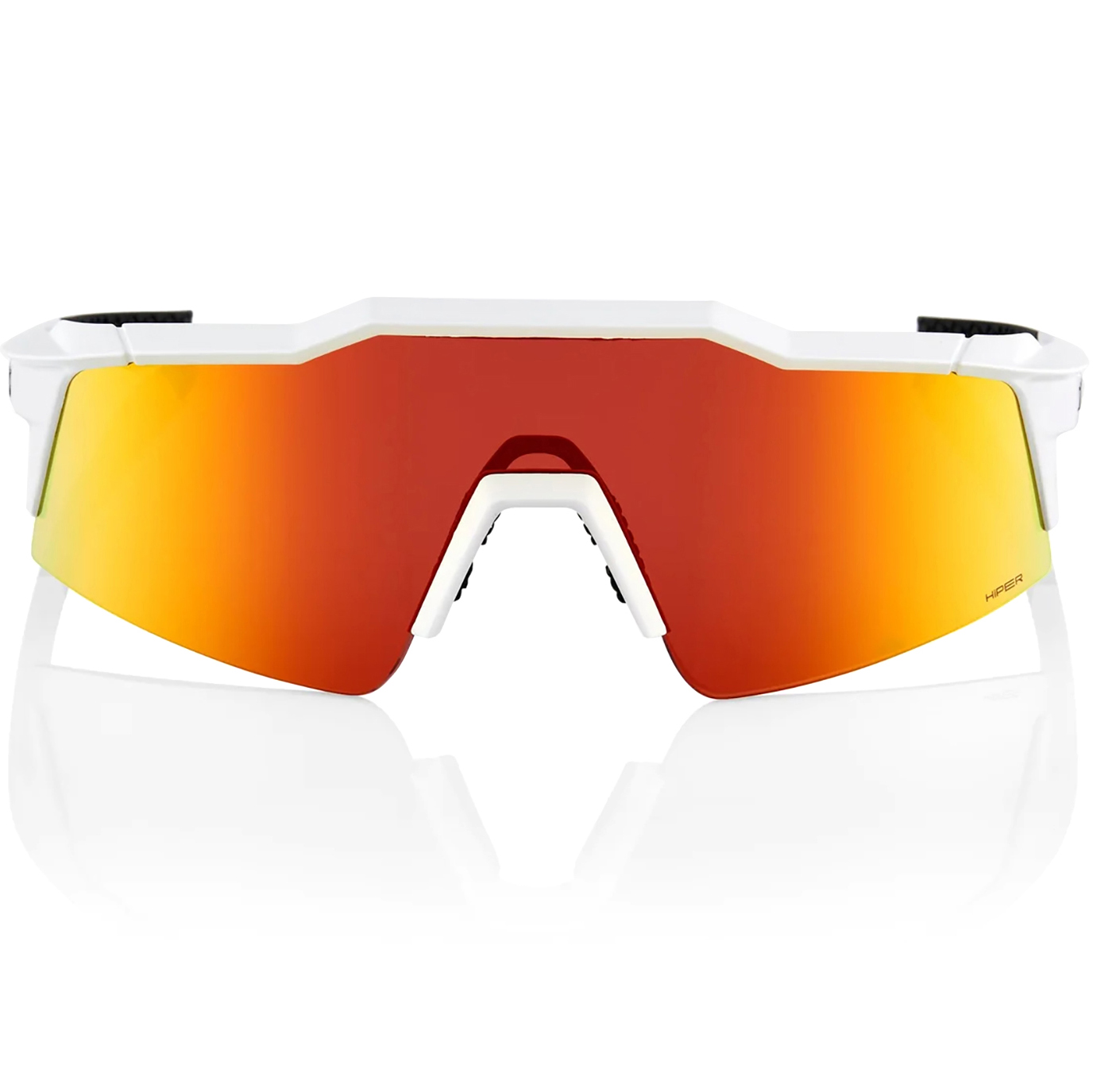
Best field of vision mountain bike sunglasses
A premium pair with an ultra-wide, unencumbered field of vision and a featherweight feel.
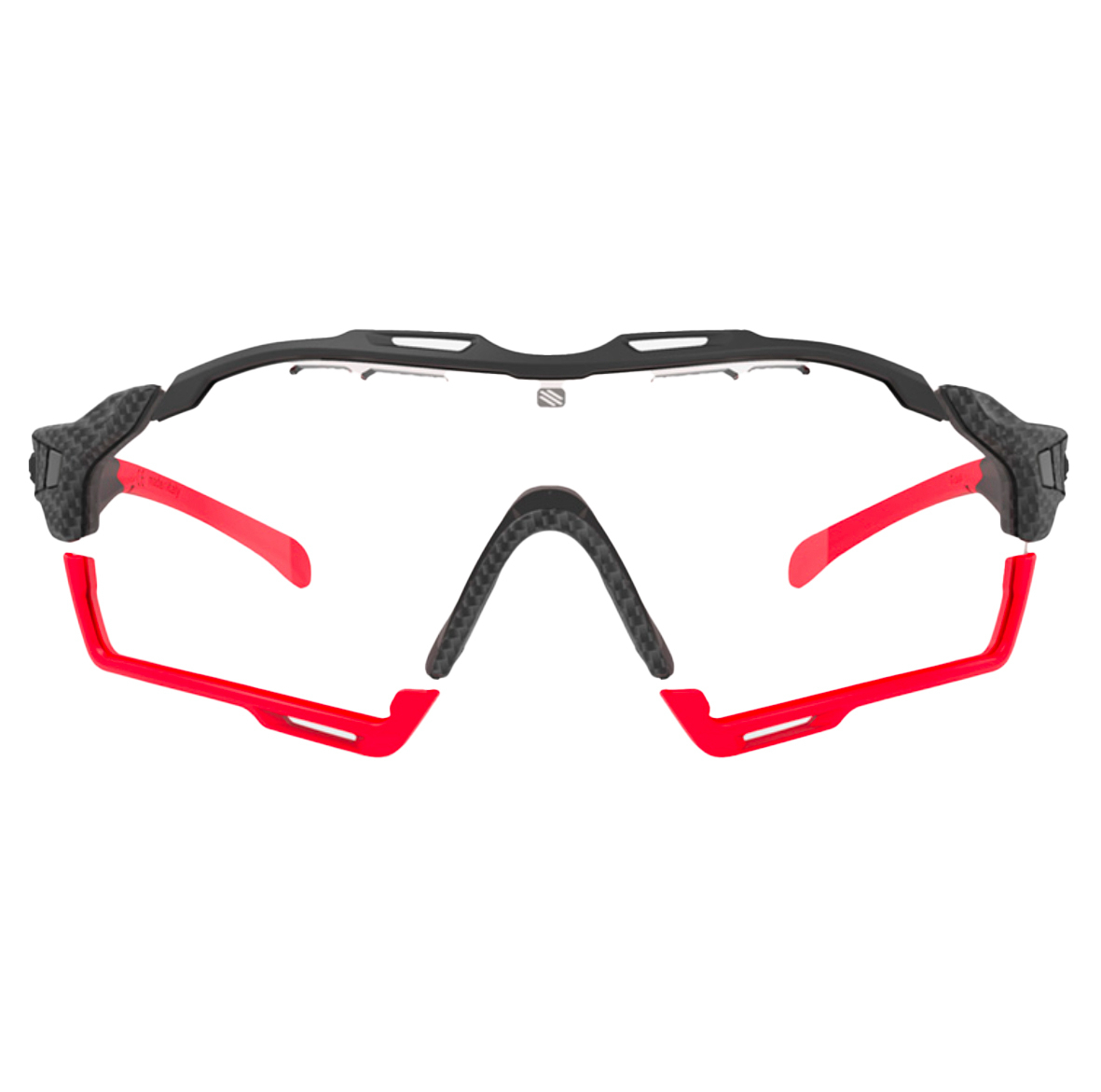
Best photochromic sunglasses
With a super tough lens, the Cutline is available with photochromic lenses and comes in a range of frame options.
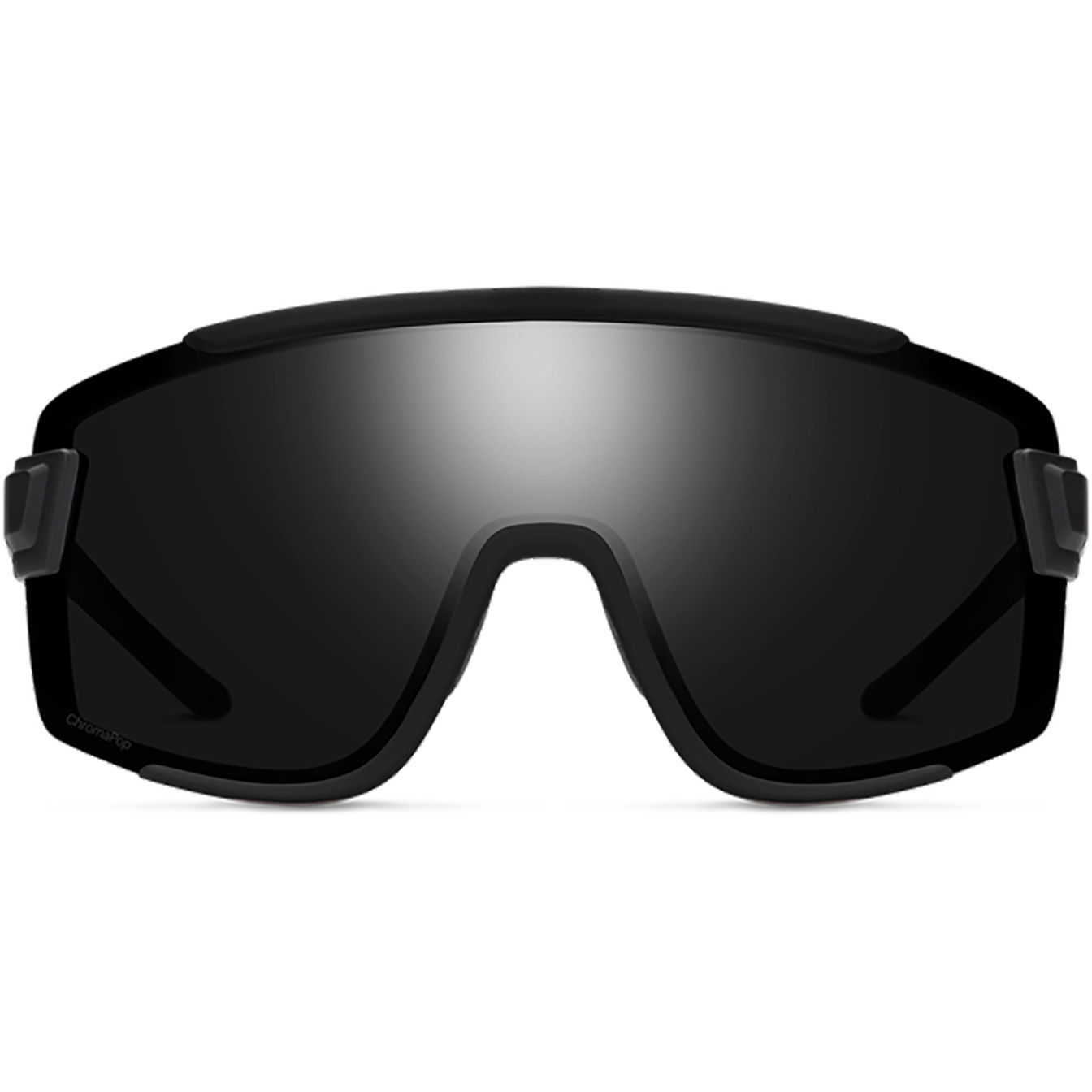
Best fit mountain bike sunglasses
Outstanding maximum coverage optics with a stable fit and soft touch comfort however rowdy your riding gets.
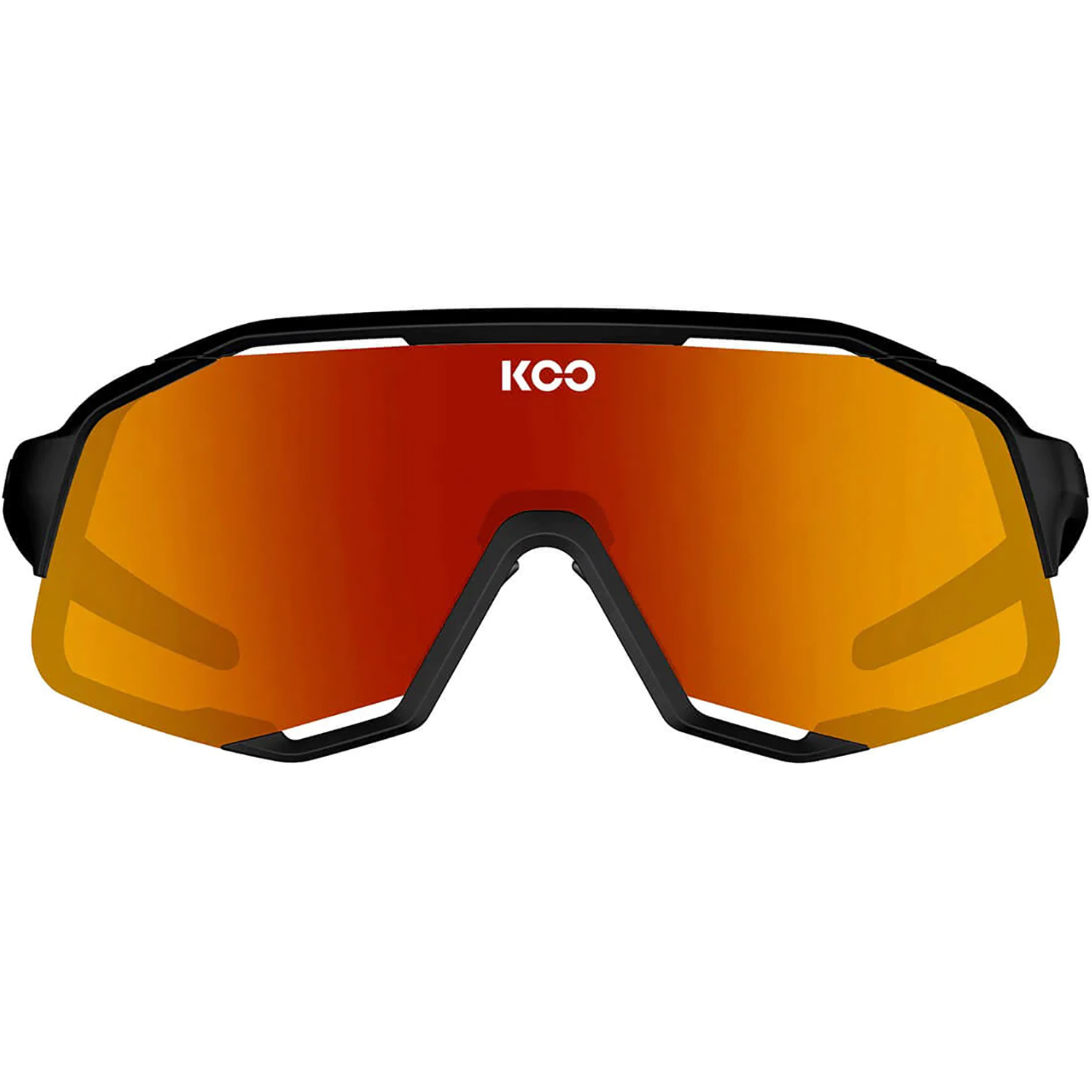
Best mountain bike sunglasses for
optical clarity
Stylish, stable and sturdy with excellent Zeiss lens that wraps around the face to give better peripheral vision.
See the next 4 sunglasses ↓
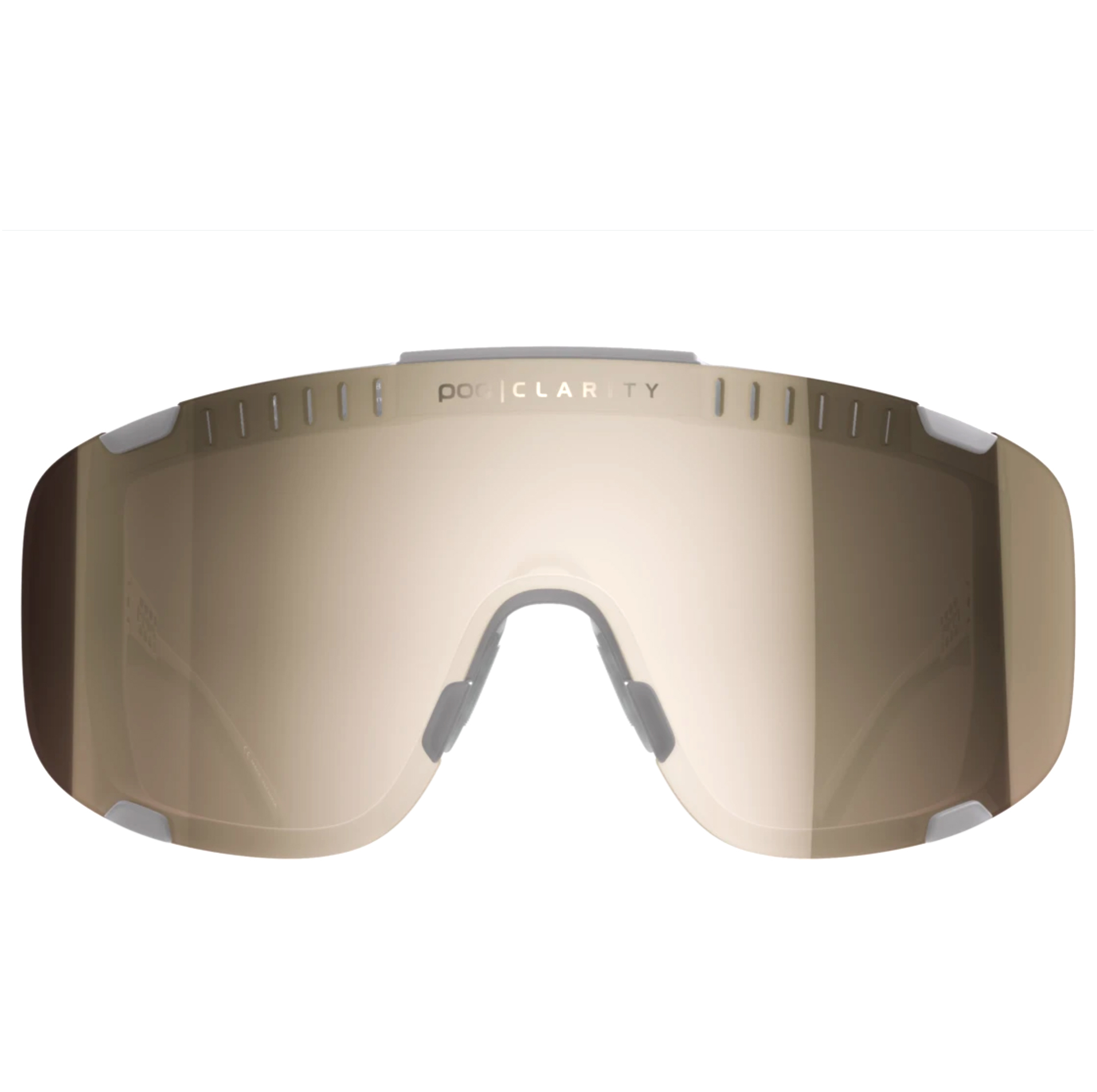
Best mountain bike sunglasses for coverage
POC's Devour lens extends far beyond the glasses' frames to give unmatched amounts of coverage.
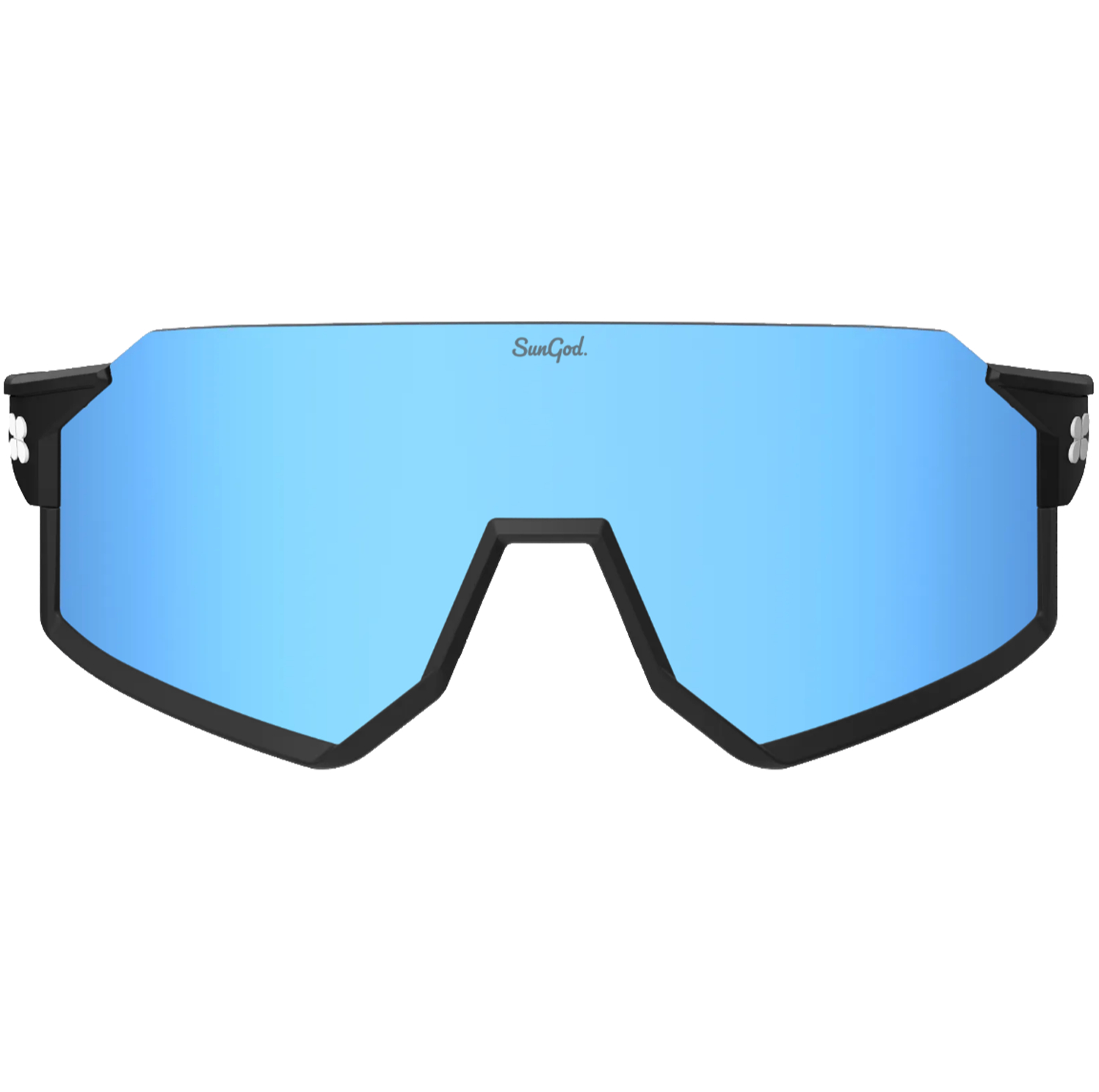
Best mountain bike sunglasses for low light
SunGod offers a wide range of lenses for the Airas including a range of tints, two photochromatic lenses, or a clear option.
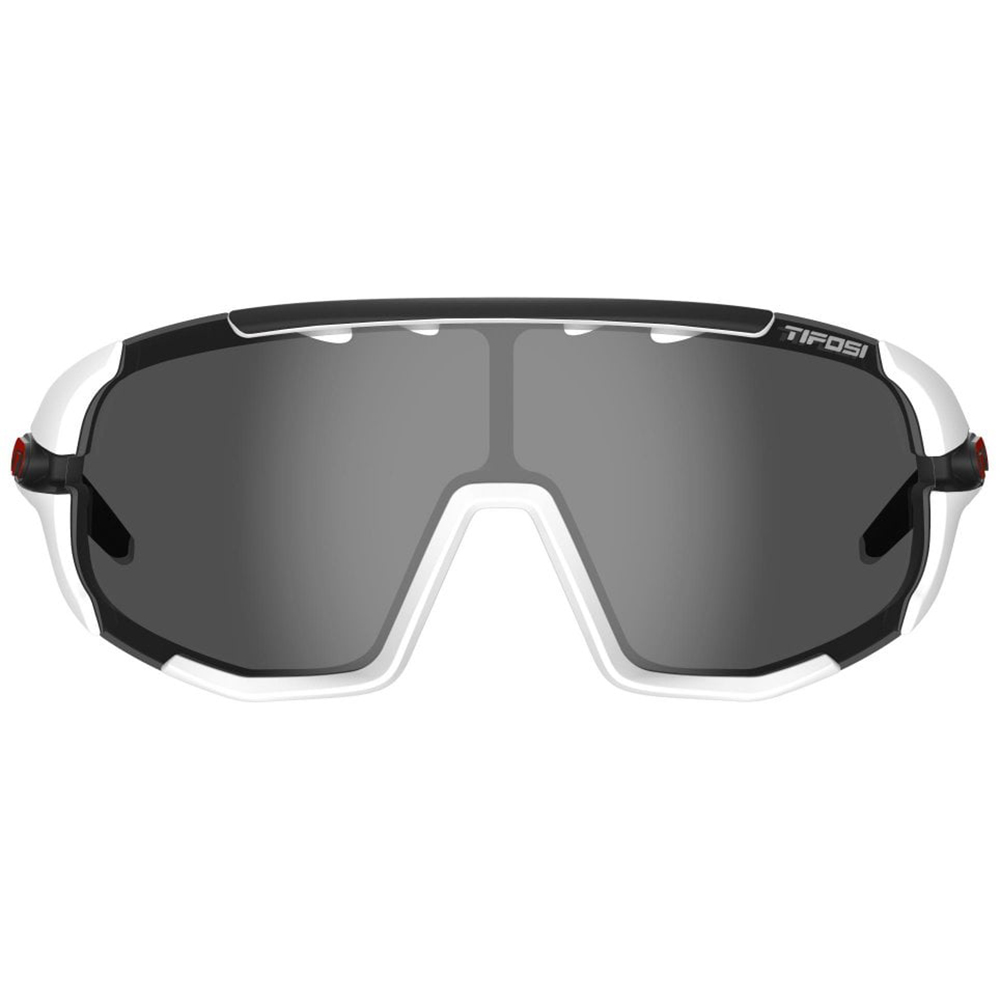
Best affordable mountain bike sunglasses
Huge coverage lens at a wallet-friendly price tag, and comes with several lens tint options.
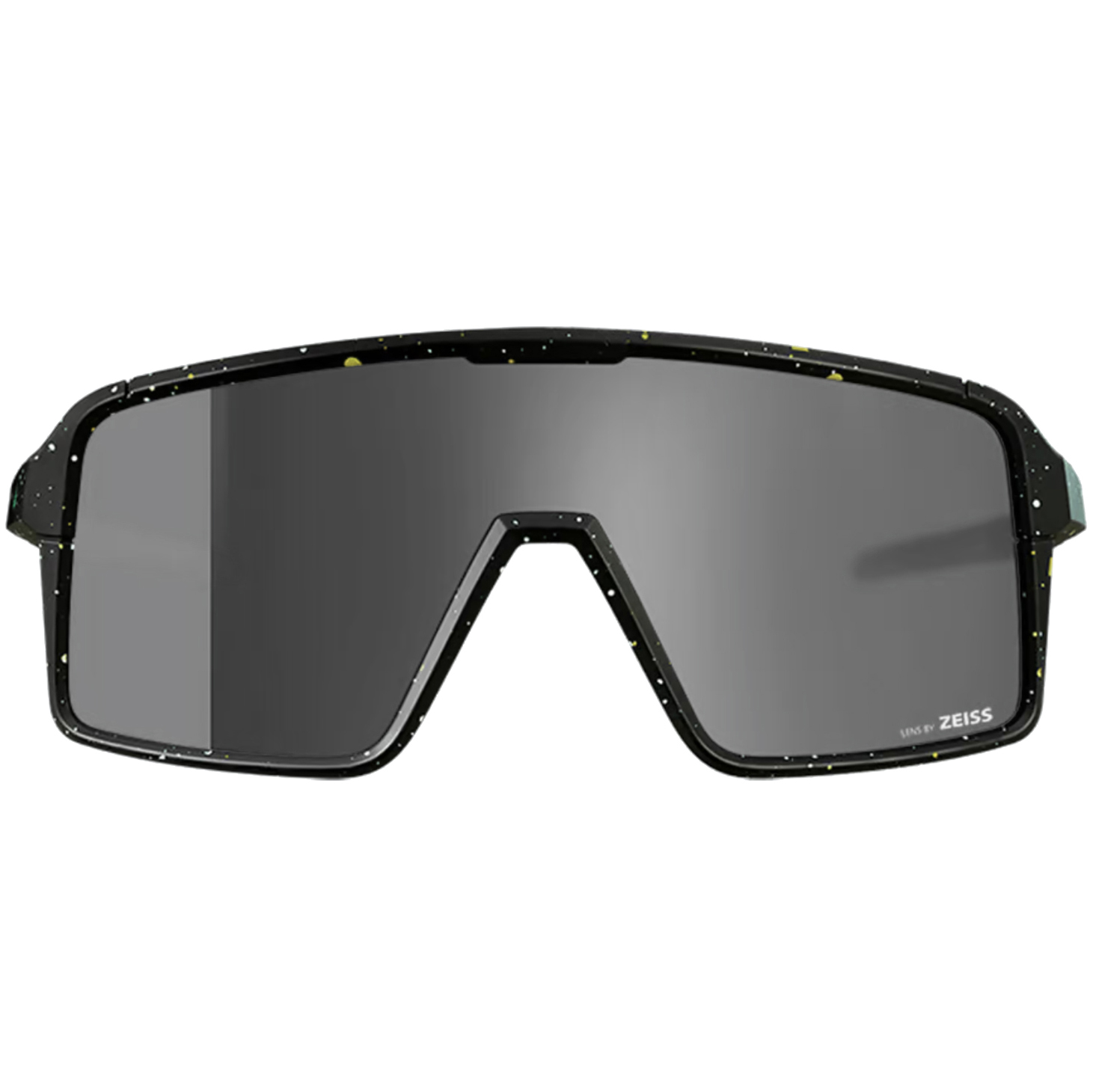
Best mountain bike sunglasses for customization
Excellent quality and with the wide range of customization options you can create your own unique pair.
Best overall
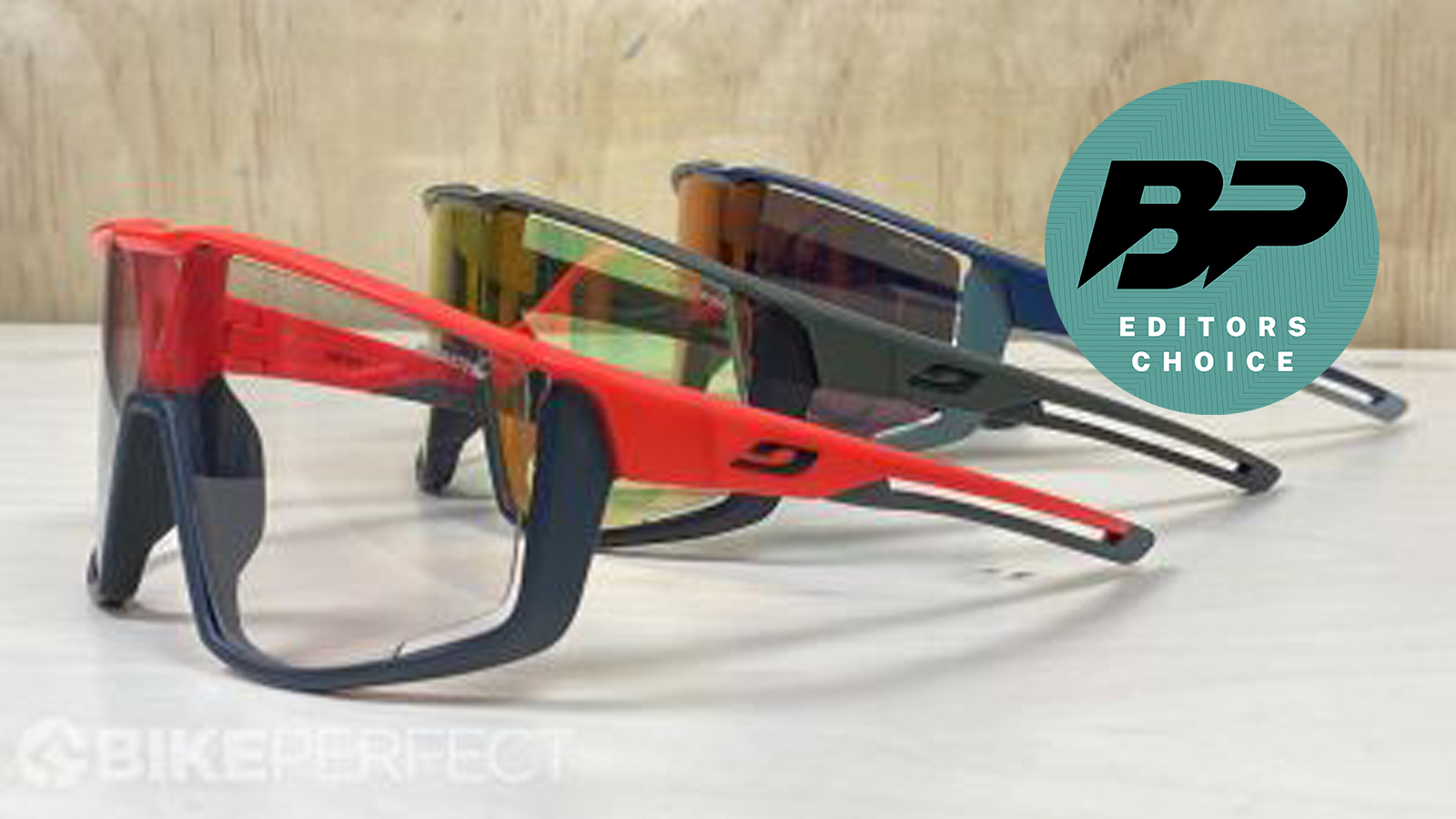
Specifications
Reasons to buy
Reasons to avoid
All Julbo Fury models use the same lightweight full coverage frame which holds the lenses in the center only to stop distortion and make switching optics super easy. Ventilation gaps right across the top and sides and a lower edge cut-out keep steaming up to a minimum, too.
You can see the frames themselves all around your peripheral which might annoy some but we found it's not enough to significantly reduce the field of vision. The soft shock-absorbing fixed nose pieces and cunning ‘violin bow’ elastomer ear grips keep the Fury secure even on the most furious descents without sticking to hair. The locking hinges are still firm on all three sets even after months of heavy use and there are Fury S glasses for smaller heads.
We found The Class 1 optical quality is excellent with various fixed tints available. What really sold us on the Fury however was its outstanding toughness. We've been wearing three sets of Furys in pretty much constant rotation for several months and they’re still virtually unscathed.
Our reviewer Guy Kesteven reported: "I normally temper my excitement at getting fancy new specs as I know they’ll somehow be ruined within a few weeks. Not only does the Julbo Fury offer zero distortion, steam-free clarity, secure comfortable fit and full coverage protection in a variety of easy switch optics and frame colors, it's also outstandingly tough which boosts its already good value right up to a wise investment rating."
To find out why we gave them a maximum five-star rating, read our full review of the Julbo Fury sunglasses.
Best value
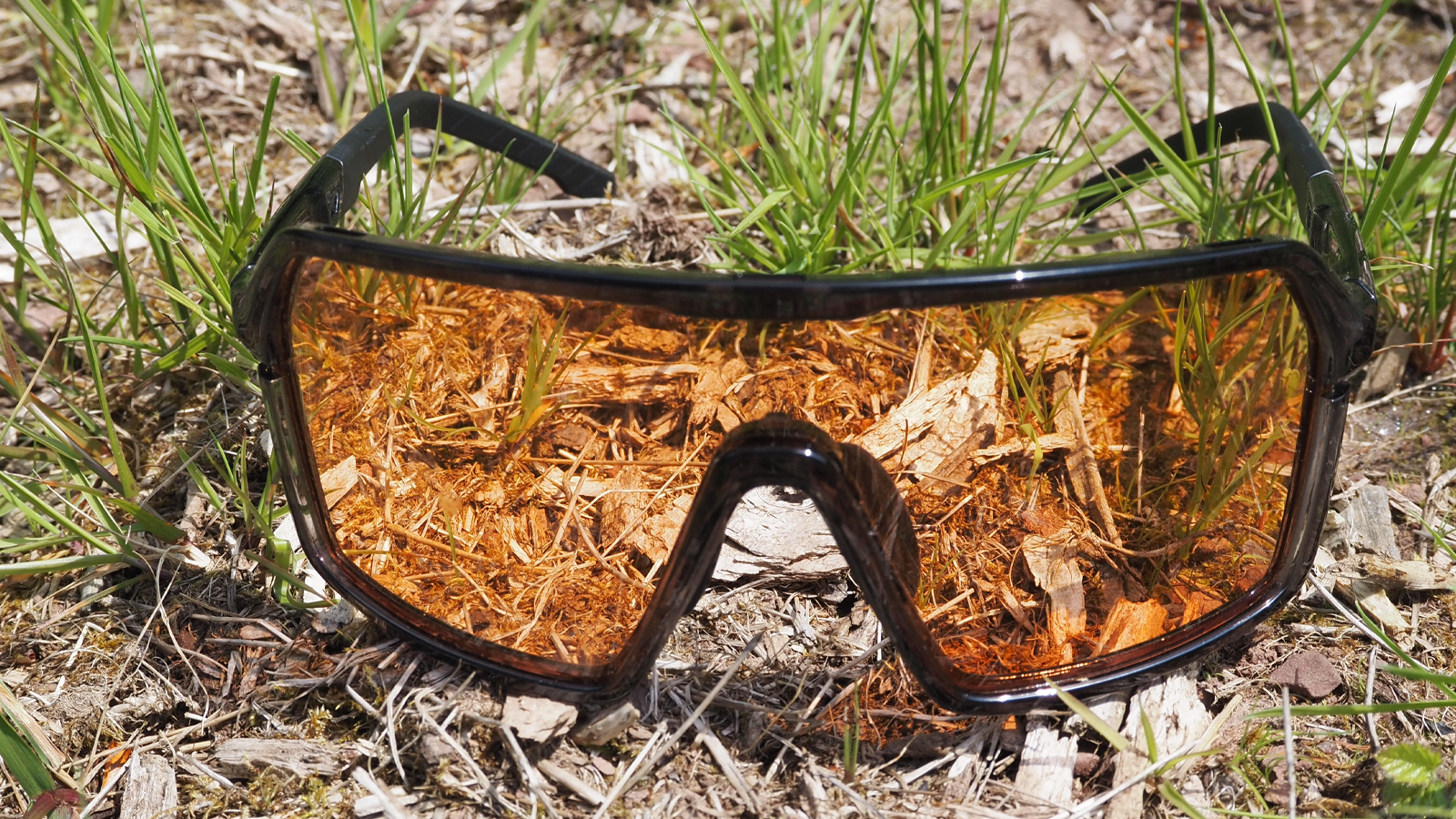
2. Madison Crypto
Specifications
Reasons to buy
Reasons to avoid
The name isn't the only on-trend feature with Madison's Crypto glasses; their large, big-coverage design is in line with all of the best glasses currently available, and the fact they produce this awesome package at a killer price point is just a bonus too.
Madison ships all Crypto glasses with three lenses, all of which best suit certain conditions and environments. While we're big fans of the clear option for UK winter riding, the tinted option is great for bright days and sunnier climates.
Thanks to the adjustable nose piece and non-slip rubber arm tips you can be assured the Cryptos are going to remain secure when riding. The addition of a sturdy hard case and soft pouch means they'll be safe when not riding too.
We're also keen on the Crypto's more casual styling, which looks good off the bike as well as on.
Best field of vision
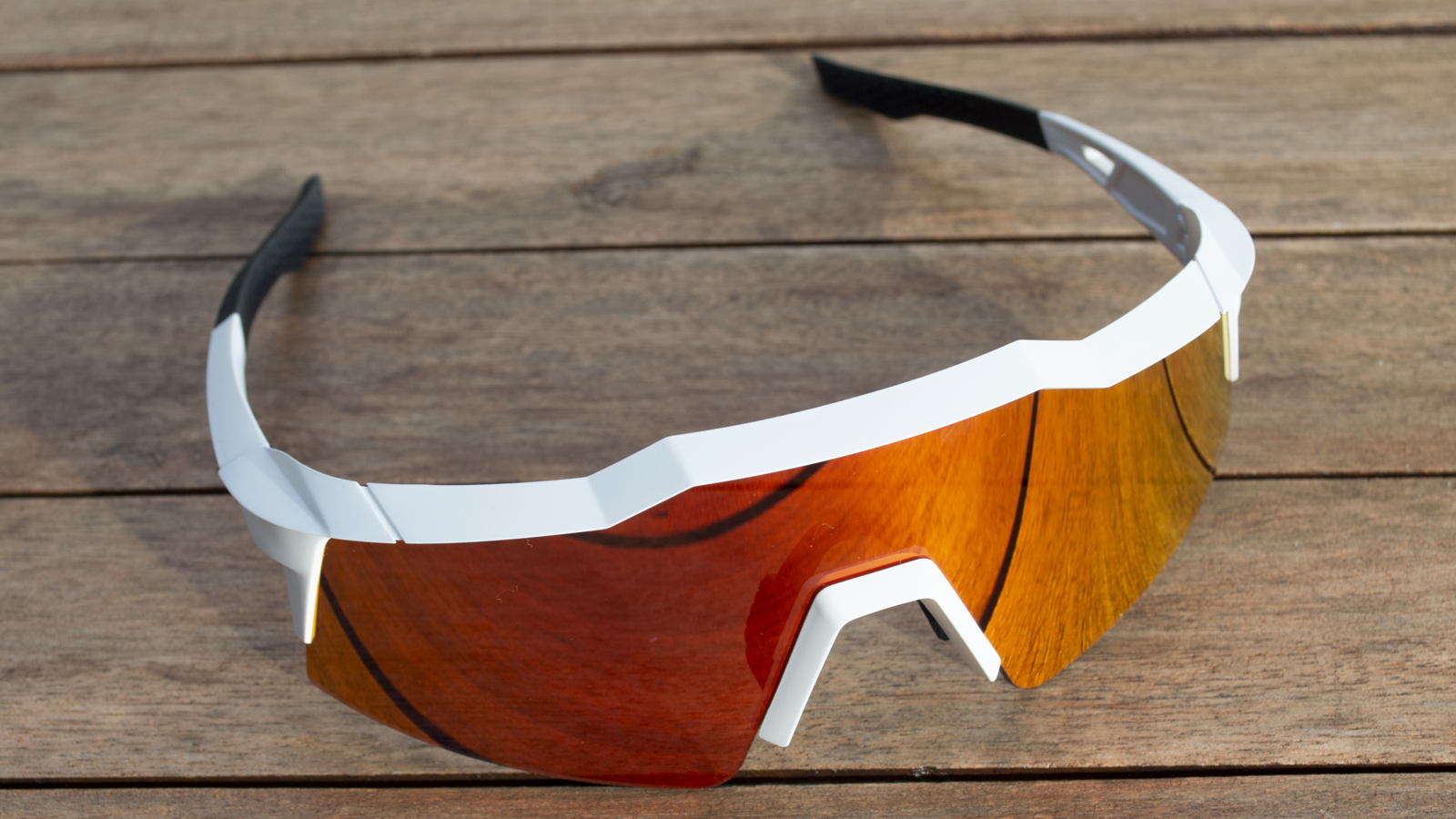
Specifications
Reasons to buy
Reasons to avoid
Don't be put off by the 100% Speedcraft SL's somewhat road-orientated stylings (they are Peter Sagan's glasses of choice) as they are a great choice for off-road use too.
With a feather weight and an almost completely uninterrupted field of vision, we found it's easy to forget that you're wearing them. The pair we've been testing come with the mirrored lens, clear lens, soft case and spare nose grip that all fits nicely in a hard case.
The hydrophobic lenses stop large water beads from forming and while we found they occasionally misted up when we were working hard, the fogging quickly cleared. The Speedcrafts may look a little delicate, but we've been riding in them on muddy, wooded trails for a while now and the lens is still scratch free.
Our reviewer Rich Owen summed up: "The 100% Speedcraft SL is a premium piece of eyewear and also one of the best riding glasses we’ve ever tested. The overall package is a comprehensive one and helps make these top-end glasses a worthy investment."
Check out our full review of the 100% Speedcraft SL sunglasses.
Best photochromic
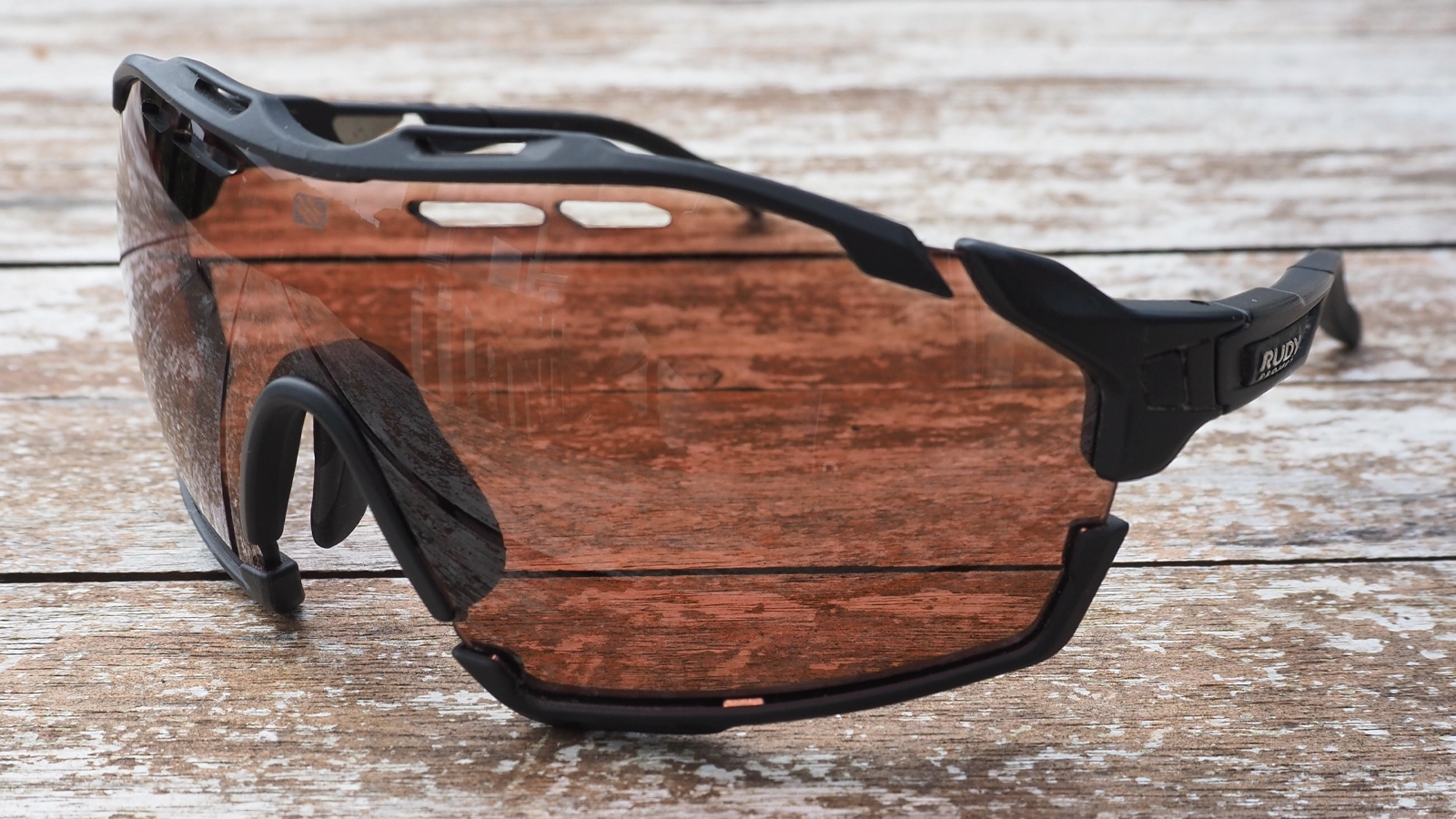
Specifications
Reasons to buy
Reasons to avoid
We've tested a number of different glasses with photochromic lenses and while they all darken rapidly, they take several minutes to clear again – which isn't great when you plunge from full sun into dark wooded trails. What makes the Rudy Project Cutlines stand-out from the competition is its red-tinted ImpactX 2Laser lens which works well even when fully darkened on dimly lit trails.
Another standout feature we were really impressed with was how well the lens resists damage even after months of mistreatment during testing. Despite being shoved in pockets and packs – even when already dirty – the lens is still scratch and blemish-free.
It also stubbornly resists fogging most of the time. We did get some faint misting when coming to a stop after arduous hot climbs, but it cleared rapidly as soon as we started moving again. Tester, Rich Owen, summed up the Cutlines as "Overall, these are the best photochromic sunglasses for MTB we've ever tested."
For more, see our full Rudy Project Cutline review.
Best fit
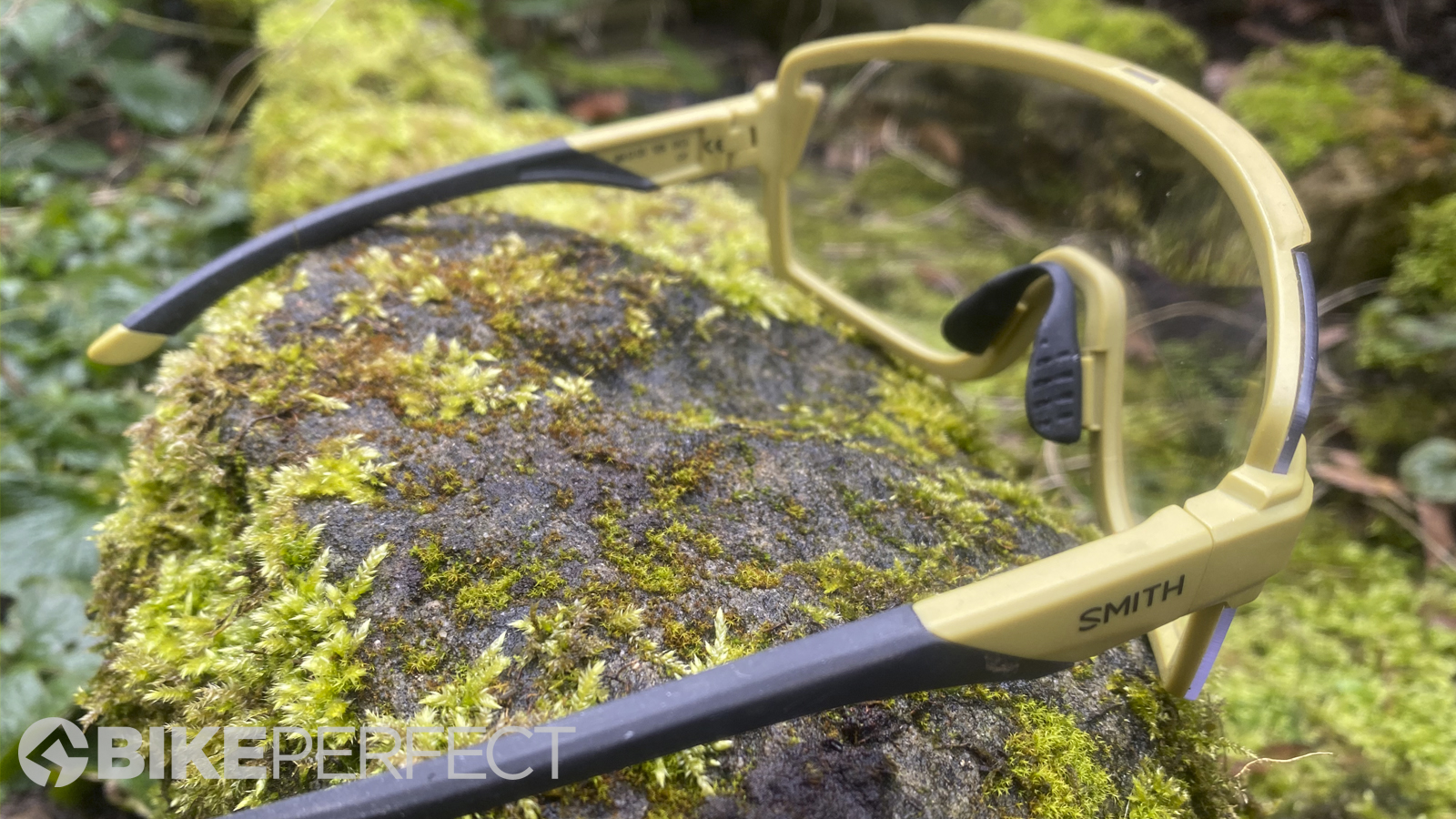
Specifications
Reasons to buy
Reasons to avoid
Compared to average glasses the Optics are absolutely outstanding. While the weather meant we didn't have a chance to wear the dark ChromaPop lens in the Wildcats, we wore them loads in Squad goggle guise. We’ve always loved the clarity they deliver and how fresh they keep our eyes feeling even in changeable conditions. Considering the full wraparound coverage and the flexible/replaceable frame design, the complete lack of distortion from the '5 base' cylindrical lens is exceptional, too. That particularly helps in low light or long day situations where eyes can get confused more easily and have to work harder to assess the trail and surroundings.
We found the soft contact points, lightly sprung arms, 32g weight and minimal frame intrusion in your peripherals make it very easy to forget you’re even wearing them which is probably the best comfort compliment we can possibly give. They shed water off the lens pretty well too and there’s certainly no reduction in the totally solid fit security when wet. Ventilation and de-fogging are excellent too, so you can hammer climbs on hot days without having to stick them in your helmet or wave them about before diving straight into a descent.
Our reviewer Guy Kesteven summed up: "Smith’s Wildcats are outstanding maximum coverage optics with an exceptionally stable fit and soft touch comfort however roasting or rowdy your riding gets."
Read our Smith Optics Wildcat review for more details.
Best optical clarity
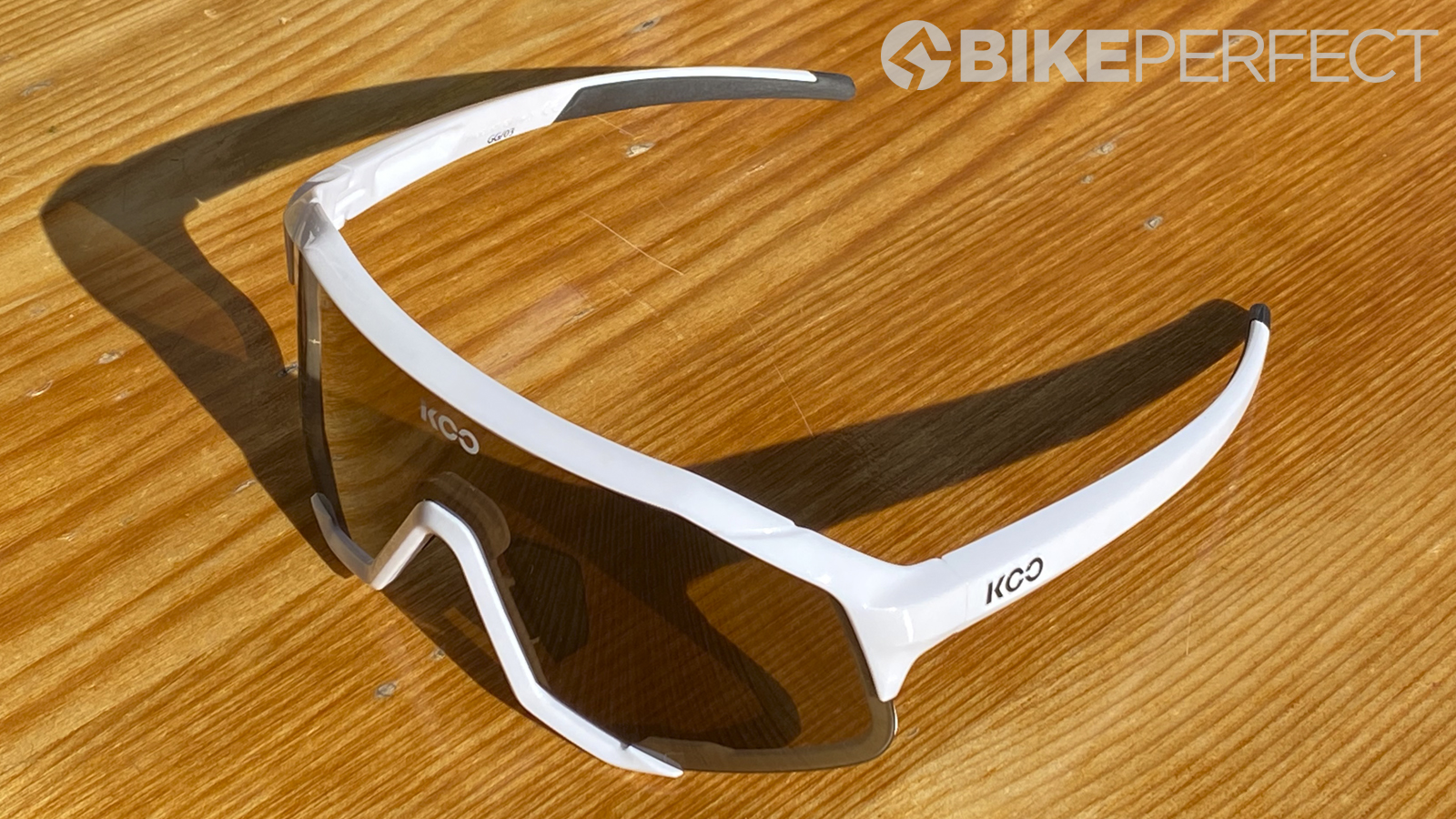
Specifications
Reasons to buy
Reasons to avoid
Koo is the sunglasses partner for the helmet manufacturer Kask, and has a small range of sunglasses from casual to premium on- and off-road performance models. Spectros and Demos are at the top of this range, with the Demos being more orientated to off-road use, whether that's mountain biking, cyclo-cross or adventure riding.
They come with a Zeiss lens that wraps around the face to give better peripheral vision. The lens is vented and the glasses sit reasonably away from the face to keep them fog-free, although in our tests we found that does invite the possibility of more dust, bugs or debris getting inside.
Thin arms, two-position adjustable nose piece, ribbed nose pieces and Megol elastomer strips meant they played well with every helmet we tried them with, and we found they stayed securely in place when riding.
Our reviewer Guy Kesteven reported that the, "Demos sunglasses deliver excellent optical clarity in a stable, comfortable format. They’re particularly good if you spend a lot of time head down, looking up in an aero tuck."
Find out more in our review of the Koo Spectro and Demos cycling sunglasses.
Best for coverage
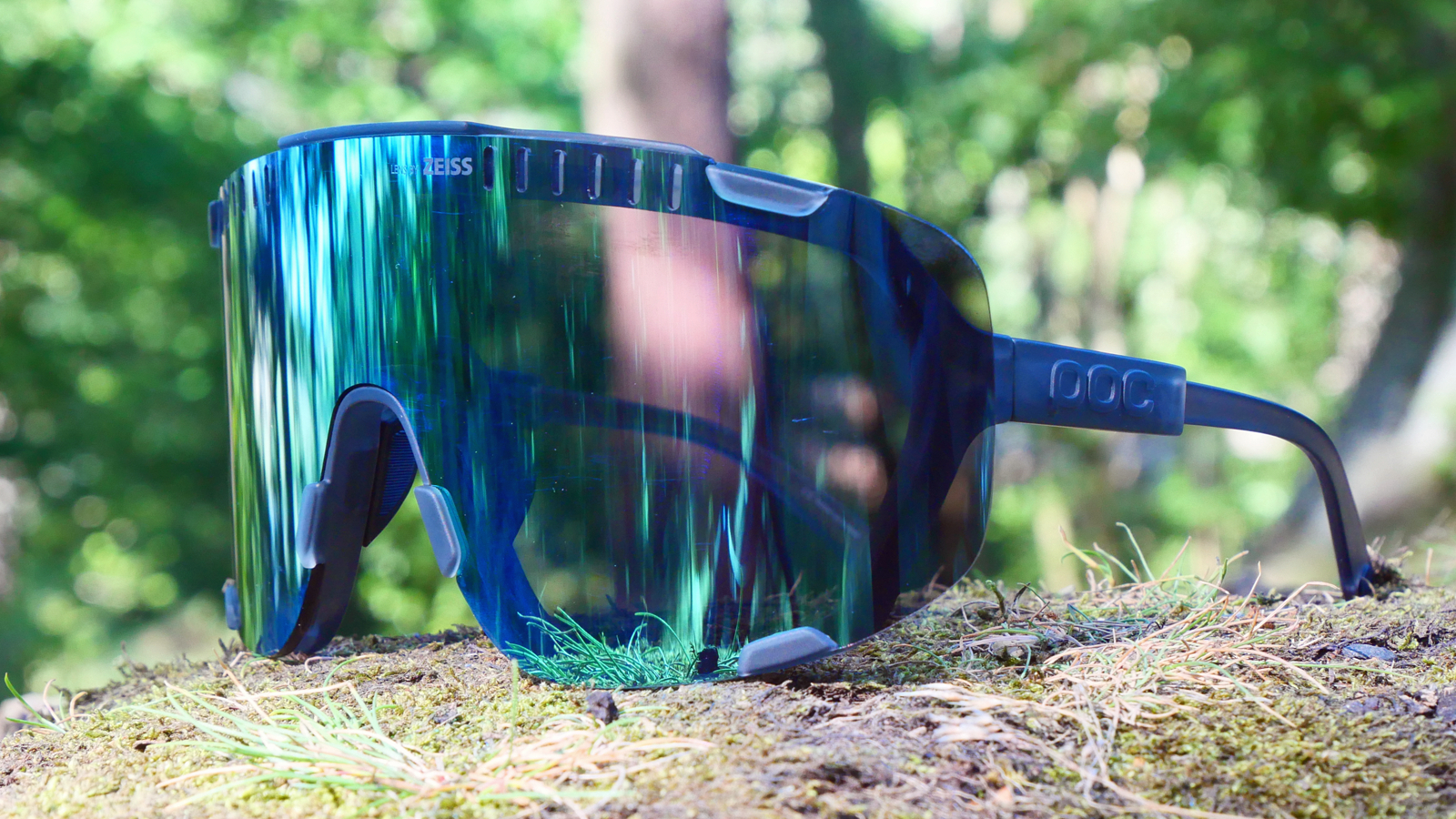
Specifications
Reasons to buy
Reasons to avoid
Big sunglasses are on trend and whether you think they look cool or ridiculous, larger lenses have their benefits, offering a better field of view and more protection. If you are looking for the biggest pair of mountain bike sunglasses, nothing comes close to the POC Devour.
The huge interchangeable Carl Zeiss lens is mounted over the front of a smaller full frame which allows POC to offer unmatched coverage without effecting the ergonomics of the glasses. There is the option of a regular lens, Clarity Trail, or Clarity Road which gives complete protection from harmful UVA and UVB rays and is treated with an anti-scratch and Ri-Pel hydrophobic and oleophobic treatment to combat dirt, water, and sweat.
While they are designed to pair perfectly with POC's own helmets, we found they played well with all the other MTB helmets we tried too, despite the massive size. The adjustable arms sit close to the head to avoid any interference with deep helmets, although the hooked ends means they don't work with most in helmet storage.
Our reviewer Graham Cottingham reported: "Unless you want to wear goggles, no other eyewear offers close to the coverage and field of view as the Devours making them one of the best options out on the trail. The comfortable fit means they will also cross over to gravel and road duties too."
For more details, check out our POC Devour review.
Best for low light
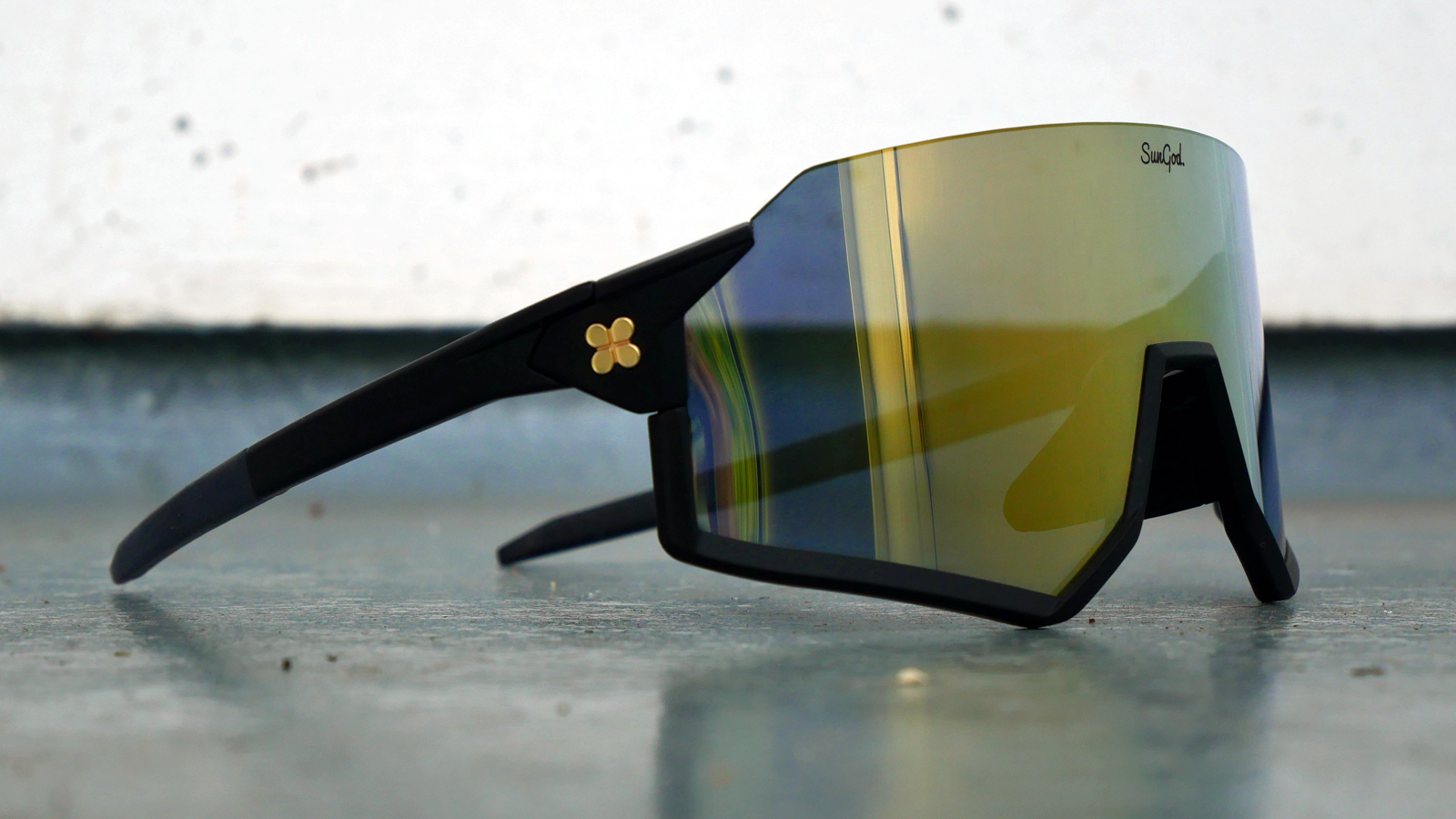
8. SunGod Airas
Specifications
Reasons to buy
Reasons to avoid
SunGod's Airas are a highly customizable set of premium eyewear for mountain biking, gravel, and road. While having the options to personalize every single part of the glasses is great, the best thing about the Airas is the 8KO SunGod lens options you can choose from. There's a whole range of tint levels, two photochromatic options, or clear lenses. The 8KO Iris Smoke is particularly good if you are riding in changeable conditions.
Aside from the custom options, they also have a great fit thanks to the flexible frames and low weight. The lenses are large as well, giving plenty of face coverage, and the glasses can be converted between bottom frame or zero frame styles.
Best affordable
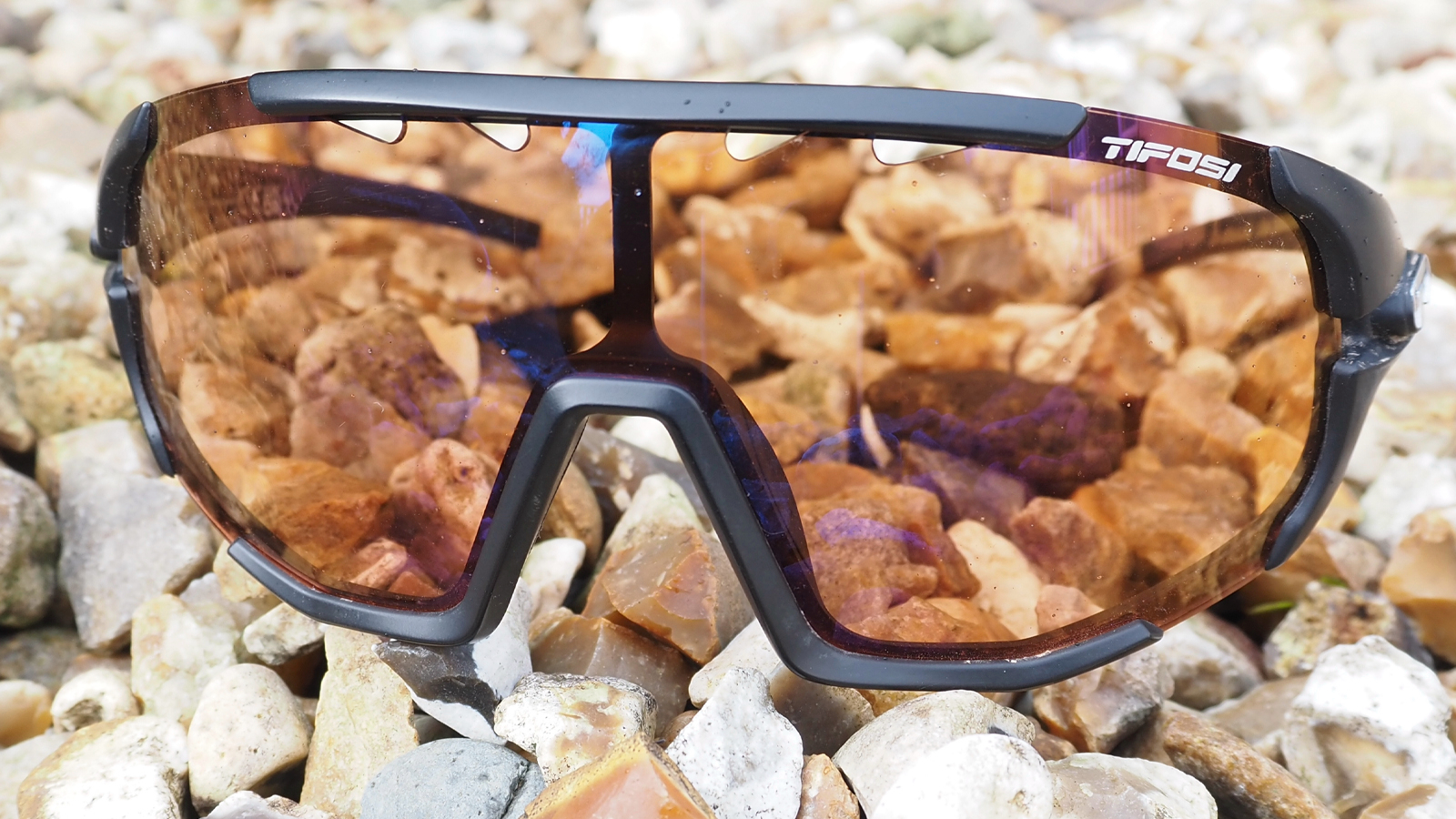
Specifications
Reasons to buy
Reasons to avoid
Tifosi is best known for designing top-performing sunglasses in all shapes and sizes at super-affordable price points. The Sledge is its latest large lens option and sets to bring big coverage and styling with a wallet-friendly price tag.
The Sledge comes equipped with Smoke, All-Condition Red and Clear interchangeable lenses. Not only does this make them great value, but it also means there's a lens tint option for every condition imaginable.
It's not just the lens that's been well thought out though; on top of the major styling the frame sees ventilation and aerodynamics in equal measure. Included in the box are a zipped hardshell case and a soft microfiber cleaning pouch.
Bike Perfect editor, Rich Owen, tested the Sledge glasses over several months and summed them up as "quality riding glasses with three interchangeable lenses that cover every light condition. They come with a very reasonable price tag too."
For more info, see our full Tifosi Sledge review.
Best customization
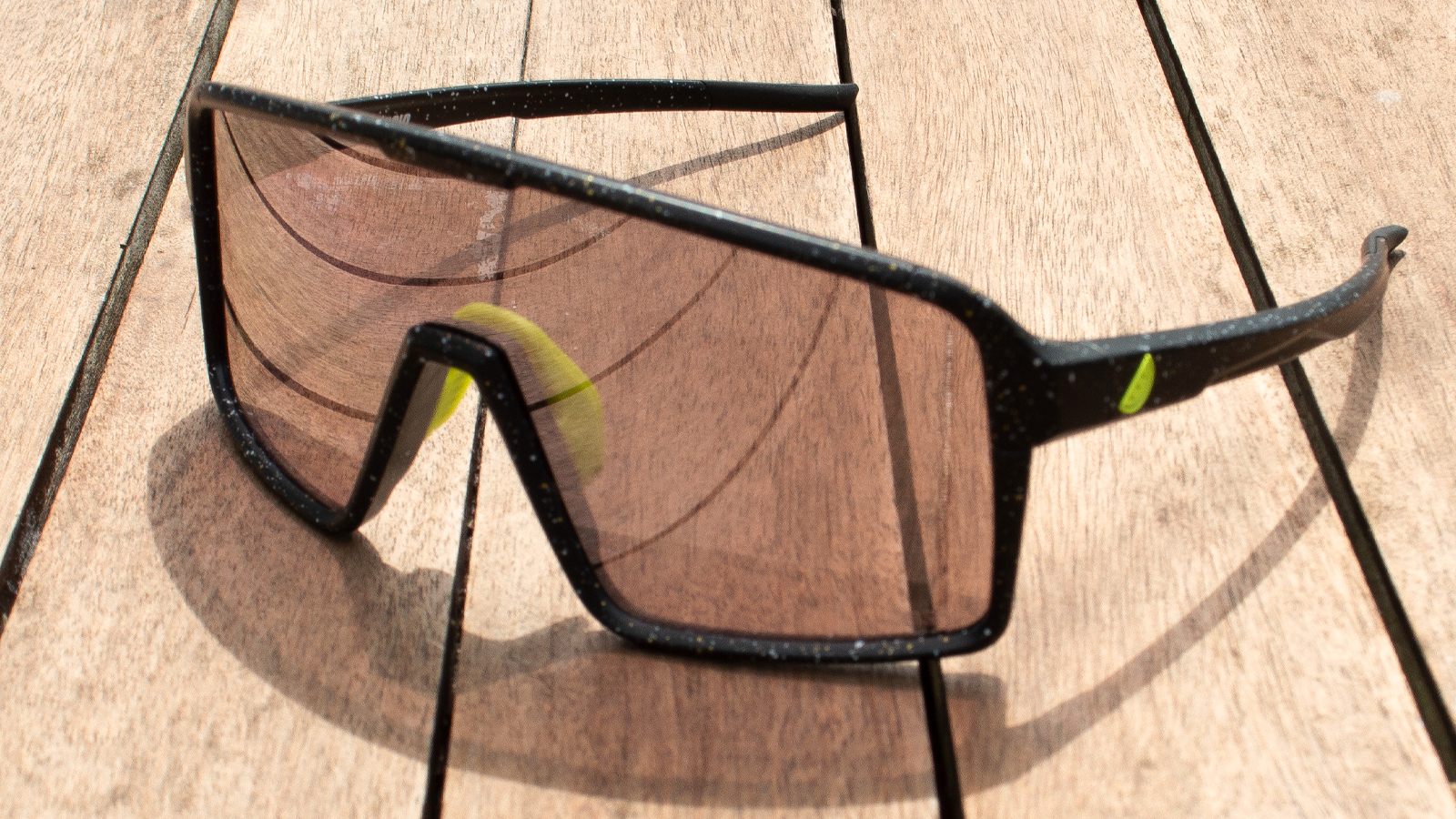
Specifications
Reasons to buy
Reasons to avoid
The Kingpin is the latest offering from online only retailer, Melon, which follows on from its popular Alley Cat glasses. Built around a large, quality Zeiss lens, you can make your Kingpins almost unique with a host of customizable options that come as part of the standard price from Melon's website.
They're not cheap, but when you consider the package includes a spare (low light) lens, plus a hard and soft case, they're decent value overall.
Quality-wise, they're up there with the best riding sunglasses around. In our tests they performed well in a wide range of conditions – we found the lens gives excellent clarity and field of vision and they are well ventilated so we had no problems with misting. However, the flared arm tips did cause issues with some of the deeper fitting trail helmets we tried the Kingpins with.
Our reviewer Rich Owen reported: "They are comfortable and you can barely feel them when wearing, while the lens gives excellent clarity and a great field of vision."
For more info, check out our full review of the Melon Kingpin sunglasses.
How to choose the best mountain bike sunglasses
With so much choice out there, it can be really difficult to make a decision. Luckily we're here to help, so if you're struggling to figure out which mountain bike sunglasses would suit your needs more, here is everything you need to think about first.
What type of coverage should I look for?
When it comes to protecting your face from errant trail debris, the larger the lens, the better the coverage. However, too big, and not only will you look like the third member of Daft Punk, but your glasses will likely interfere with your helmet.
Ideally, the best mountain bike sunglasses have some curvature to wrap around your face for a bit of side protection but also to prevent wind and light from sneaking around the edge and making your eyes water.
What type of lens is best for mountain biking?
Leave your sunnies with glass lenses at the trailhead. We love a good set of Ray-Bans or other fashion-focused shades, however, if they have a glass lens, you're putting your eyesight in danger. At the risk of flogging a dead horse, the primary duty of eyewear on the trail is to protect your eyes, so when that pebble your riding mate kicks up hits the glass sitting in front of your peepers at 60kph, what do you think is going to happen? Instead, go for sunnies with polycarbonate lenses or similar impact-rated material that won't shatter into your eye.
Also, look for some type of hydrophobic coating at the very least on the outside of the lens. When moisture and oil come into contact with your glasses, whether it be from a stream crossing or sweat dripping out of your helmet, a lens with this coating will bead and run off instead of smearing and obstructing your vision.
It's also worth looking for a bit of venting in the lenses to prevent them from fogging as you slog up a steep fire road.
What color lens works best for mountain biking?
Most of us will encounter various amounts of tree cover when mountain biking, so having the right color and tint lens makes a huge difference in seeing that slick root well before you ride over it. Lenses with red or amber tints increase contrast and help your eyes pick out trail details – even in dimmer light conditions such as woodlands.
Many optical brands are offering color filters on their lenses, like Oakley's Prizm and Smith's ChromaPop. Each brand's system is slightly different, but they all use special dyes to filter individual colors to increase contrast and for better detail recognition and depth perception.
What frame do I need?
The frame of the best mountain bike sunglasses will largely determine their fit. Avoid metal-framed glasses as they are not designed to withstand any kind of impact, and in a crash, they will create sharp edges around your eyeballs and face.
The majority of riding glasses are half-frame, meaning the frame will connect to the lens on the top half, leaving the bottom edge exposed; though a new crop of riding sunnies like the Oakley Flight Jacket and Ryders Roam see the frame run along the bottom edge of the lens. There are also plenty of full-frame and frameless glasses, too.
Is the fit important for mountain bike sunglasses?
A good pair of glasses should only touch your nose and your head just behind the ears. You want to look for a rubber nose piece with a bit of adjustability built-in, and the ear stocks should have plenty of length, but shouldn’t be so long they interfere with the retention system on your helmet.
As these three points are what keep your glasses stuck to your face, in addition to the rubber nose piece look for grippers on the ear stocks, which should provide enough tension to hold the glasses on but not give you a headache.
How we test the best mountain bike sunglasses
Our experts tested these sunglasses out over several months in different light conditions, and various weathers, from cold and wet to dry and dusty. We assessed their performance in a wide range of categories, including coverage, optical clarity, steaming/fogging, fit and comfort, stability, weight, lens changing systems, and durability.
Meet the testers

Rich has been riding mountain bikes since the early nineties and testing bikes and kit for over a decade. He's tested many riding glasses over the years, so knows a good pair when he wears them.
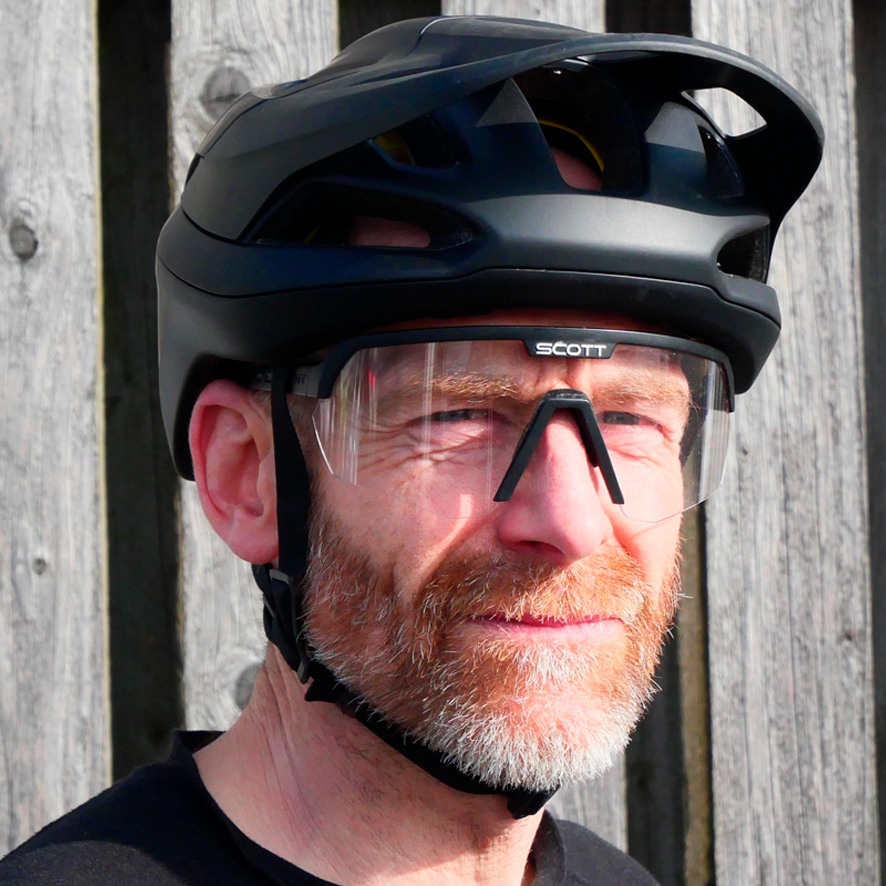
Guy's been testing and writing about mountain bikes for as long as Rich has been riding them and has tested hundreds of riding specs over the years. Look, he's even wearing some in this photo.

Graham is all about riding bikes off-road. With almost 20 years of riding experience, he has tested many pairs of MTB sunglasses in his time.

Rich Owen joined the BikePerfect team as editor in 2021. He's worked as a journalist and editor for over 24 years, with 12 years specializing in cycling media. Rich bought his first mountain bike (a rigid Scott Tampico) in 1995 and has been riding MTB for almost 30 years.
Current rides: Merida One-Forty 6000, Banshee Paradox, YT Jeffsy Core 3, Saracen Ariel 30 Pro
Height: 175cm
Weight: 69kg
- Paul BrettStaff writer
- Guy KestevenTechnical-Editor-at-Large
- Graham CottinghamSenior reviews writer, Bike Perfect
